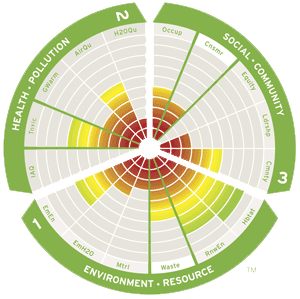Pharos Project Readies New Environmental Assesment Tool
The Pharos Project, named after an ancient lighthouse in Alexandria, Egypt, is a new kind of environmental assessment tool being developed by the Healthy Building Network.
The tool includes 16 environmental criteria broken into three categories: Health and Pollution, Environment and Resource, and Social and Community. Users will be able to see and judge a product’s environmental ratings for each of the attributes with the Pharos Lens — a series of “wedges” for each environmental attribute that clearly illustrates how a product rates.
According to the Pharos Project Web site (www.pharosproject.net), “The goal of Pharos is not to supersede other efforts to establish performance standards based on industry consensus, but rather to put those standards in context. Pharos will be designed to reflect the fact that most current green standards are just mileposts, at best, on the road to green and, at worst, they lead the user astray.”
Because there are many single-attribute green certifications, Pharos is designed to consolidate those criteria into one, easy-to-read source. “The idea is to augment and clarify the third-party certifications,” says Larry Kilroy, information systems director for the Healthy Building Network.
Tom Cooper, principal, environmental design and research, Kaiser Permanente, says he’s excited about the release of Pharos, because Kaiser had spent a lot of time conducting its own environmental life-cycle assessments. Now, Pharos will eliminate a lot of legwork. “Pharos will make environmental life-cycle assessment a lot easier,” he says.
Manufacturers are also invited to participate in the project by submitting product data. Pharos will then be able to tell them which environmental criteria they can improve upon and how.
The tool is expected to be released by the end of 2008, says Kilroy. It’s currently undergoing a three-month beta test. Initially, the tool will be free.
Click & View
Pharos Lens (jpeg)

The Pharos Lens provides a graphical illustration of a product’s environmental performance in several categories. Bars move from red to green, indicating better environmental performance in each category.
|
Related Topics:

















